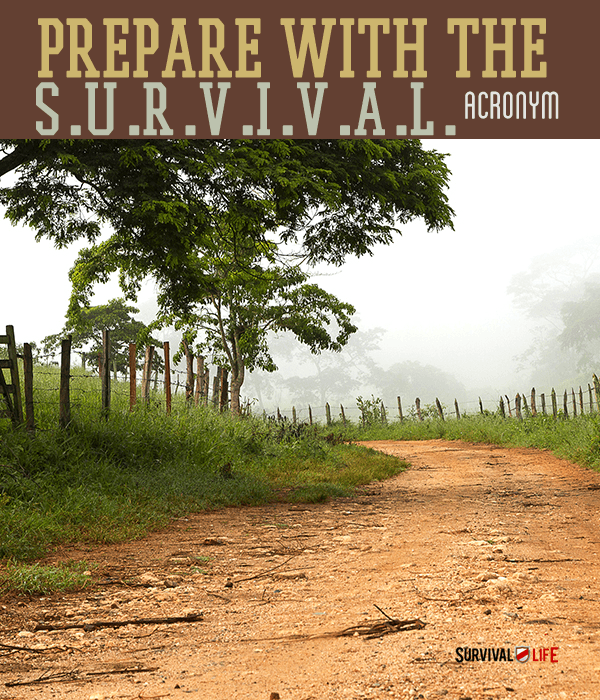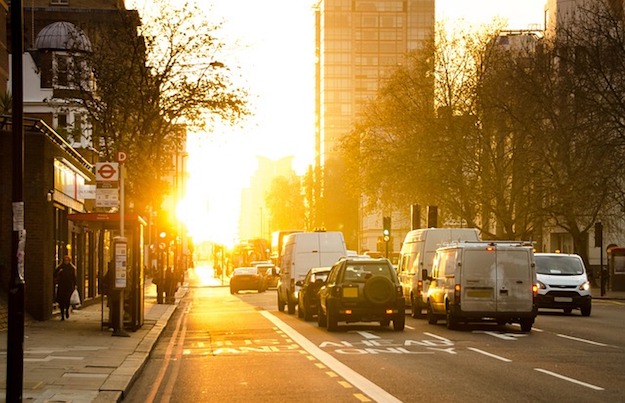Do It Yourself
Emergency Preparedness With The S.U.R.V.I.V.A.L. Acronym

The acronym S.U.R.V.I.V.A.L. is used by many in various situations to prepare; whether it is preparing for an operation, self-defense in your personal space, securing your home or prepping for man-made or natural disasters, using this simple acronym may help you have a ready way to remember to do what you NEED to do to survive.
The military originally used the SURVIVAL acronym to remind military service members what to do during a time of crisis, such as in a potential prisoner of war scenario, to avoid capture in a hostile area. I personally have used the acronym to analyze my preparations in many different areas and I recommend you do the same.
Using this acronym can be done very quickly when you find yourself in a sudden, unexpected or possibly dangerous situation, and can also be conducted in a more deliberate manner as you assess your preparations around your home, workplace and vehicles. You can also help family and friends do the same, increasing their chances of survival. When helping others assess their preparations, do so in a positive and helpful manner, as not all people fully understand or appreciate potential threats. Some folks will think you are way too cautious, that is, until something happens and they see first-hand that being prepared has saved their bacon.
The S.U.R.V.I.V.A.L. Acronym
The acronym has some letters that you will use more often than others, but all the letters are important. I will provide examples of how you can use the acronym in everyday routine situations and in dangerous scenarios:
S — Size up the situation
U — Undue haste makes waste
R — Remember where you are
V — Value Life (Your own)
I — Improvise
V — Vanquish fear (use that energy to focus, fear if channeled correctly, is a great motivator)
A — Act like the natives
L — Live by your wits
Size up the situation

This is the most used letter in the acronym. Where are you located? Specifically, are you in line in a grocery store, stuck in traffic at a stop light, in a movie theater, in your workplace, hunkering down in your shelter or in your bed at night? What is happening around you or can potentially happen around you? Is there a potential threat or dangerous situation/s that you can imagine occurring and how will that impact you? How will reduce the chances of being harmed?
For example, in a movie theater, do you pick the best seat or do you identify the exits? The next time you go to a movie, while the previews and the advertisements are running, check out your surroundings, the people and the physical layout of the theater and position yourself and adjust your readiness level accordingly. If you remember the Colorado movie theater shooter, he purchased a movie ticket, went into the theater playing his movie, went out that theater exit door and propped the door open so he could later enter from outside that door and shoot the audience as they watched their movie and their attention was focused on the screen.
Others may think it’s paranoia to consider checking your surroundings, but I guarantee if the survivors of that attack ever attend another movie they will never do so without thinking of the exits and what if… If there was one concealed carry member in the audience, the outcome may have been different and just for accuracy sake, that movie theater was a proud “weapons free zone” and had it displayed on the store font. Some places are gun free zones and that should be something you make yourself aware of as you size up the situation and plan to mitigate for or reduce the risks.
Most theaters have at least two exits; the one you entered through from the theater lobby and an exit/s in the theater leading outside. Which exit is more dangerous or more likely to have a shooter enter through? There is no one right answer; you will have to assess each situation as you experience it. In general, if a shooter enters through the lobby with hostile intent and a visible weapon, they will possibly be challenged are likely to begin firing, providing early warning to anyone paying attention and allowing exit through the other exit. However the particulars will matter, you may be in a large theater with many internal theaters that are a distance from the lobby and with the sounds of movies playing, you may not be able to hear or distinguish real gunfire from the movies.
Undue haste makes waste

Don’t rush to failure! You also should not have paralysis by analysis where you do nothing, because, you feel the need to continuously analyze a situation before you act. This simply means that you should be deliberate in your actions and not hasty. For example, you hear bump in the night, you do a quick sizing up of the situation as you shake off the cobwebs and prepare, then take action.
One scenario is you hear the noise, awaken, listen (to assess where the sound is coming from), secure your weapon and prepare to defend. In your home, You have the advantage, you know where everything is, you know the layout and you know the best place to defend from closest you. You should not necessarily rush out to investigate the noise, presenting yourself as a target for the intruder/s, but, move cautiously to identify what is happening. If you live alone or sleep with your partner in the same bed, you may be better off staying right in your bedroom, closing the door, locking it possible and prepare to defend from a concealed/covered position out of direct sight where you can observe the entry to the room and gain advantage over possible intruder/s.
If you have family members in other parts of the home, you need to pre-plan how you will move through the home in order to defend those most at risk. You should discuss this with your spouse so they know what to do if a break in occurs at night, so they know their role and then rehearse it. All of this may sound crazy and to some paranoid, but it is best to be prepared and never need to use the plan and this should not be a fair fight, anyone criminal enough to break into your home at night, is by definition, a potential deadly threat to you and your family, so you have to think about it, plan your reaction and practice it, so you can how it will go down.
As you plan and prepare remember criminals will likely choose the easiest concealed entrance into your home, for example a basement door on the back of your home that is not visible to neighbors. Remove anything that may help a criminal, such as ladders or furniture you store outside that allows a criminal to enter a window. Assess the most likely entry points from a criminal’s point of view and prepare your actions accordingly.
Remember where you are

This is the second most used letter in the acronym. You need to have the situational awareness to think about where you are and take a few seconds to do this as you go through your daily activities. For example, if you are in bumper to bumper traffic on the highway or at a stop light, how do you position your vehicle? Do you just pull right up behind the vehicle in front of yours or is it best to stay at least one vehicle length from the vehicle to your front so you can change lanes if necessary or react to a more dangerous threat as in a carjacking.
Try to remember to always be able to see the bottom of the rear tires of the car to you front and this will likely give you enough room to maneuver your vehicle. One technique criminal’s use is to pull their vehicle very close to yours or use their vehicle to bump your vehicle from behind and as a law-abiding citizen, you stop and prepare to deal with a simple vehicle accident while they approach you to carjack. If you are in bumper to bumper traffic on the highway remember where you are and if you’re the last vehicle in the traffic, turn your flashers on, leave room between you and the vehicle to your front and scan your rearview mirror.
I have been in that exact situation where I was the last vehicle in stopped traffic on the highway where the traffic jam could not be seen until the last second when the others cars behind came over a hill, so I knew it was a bad position, I scanned the rearview and when I saw an SUV fly over the hill with little time to react, I immediately pulled off to the right onto the shoulder and beeped my horn to warn others and the SUV came to screeching halt about two feet from the car I was behind, so that SUV would have hit me hard if I was not aware of my surroundings. By the way, those other vehicles were bumper to bumper and did not take any action, before that SUV came to a halt.
Value life (yours)
It may sound like a no-brainer to value your own life, but, you have to remember that it is not likely for someone else to save you, especially if you don’t take steps to save yourself. The best explanation I have for this outside of a combat situation is that if you are faced with a dangerous situation, you may feel significant fear and that fear may paralyze you if you allow it to.
It’s the fight or flight situation, where people choose to fight or run away from dangerous situations, well there is actually another option some folks choose and that is to do nothing and freeze. Most people have experienced fight or flight at some point/s in their lives, some more than others. You have to value your life and the lives of your family enough to act. In the home break-in scenario mentioned earlier, some may find it very difficult to potentially have to take another person’s life. If you ever experience this, remember what can happen to your family if you fail to act, if this does not motivate you, then I do not know what will.
If you have an adult family member residing with you, discuss this with them so they can resolve this internally, so you know if they will fight, fly or freeze.
Improvise

Simply stated, use what is available to your advantage whether it is equipment, your experience or the knowledge of others. You should be asking yourself how can I make the situation better or improve my position by repurposing something or using something in a way other than it was originally intended. The only limit to your improvisation is your imagination and knowledge level.
You can improvise in almost any situation whether it’s hunkering down to shelter in place or while you travel. For example, in an airline travel situation, where you cannot carry a firearm or bladed weapon for personal protection, you are not defenseless unless you fail to improvise. You can use anything that works as a defensive mechanism. You have items readily available on your person that can be used to help protect you as you take down an on board attacker armed with a box cutter or edged weapon. You can use a jacket or an outer garment to wrap your non-dominant arm to block and defend against cuts and strikes as you maneuver into position to strike.
If you wear a quality belt with a solid metallic buckle you have a weapon that can be swung at an armed attacker allowing you to strike them while remaining outside of their striking distance. Your belt can also be used as a restraint once you’ve subdued the attacker. You and others have shoes that can be used as projectiles that can injure and distract the attacker.
Vanquish fear

Similar to Valuing life, the way you do your best to vanquish fear is to be prepared and trained. When you are trained and prepared, you are able to act and execute on muscle memory and fear plays a much smaller role as you react to dangerous situations. I can only imagine the fear of being in my home and hearing an intruder break in and not being prepared or know what to do, that would truly be terrifying to know I had done no preparation or ability to deal with the situation. The way you overcome fear for the most part is through tough and realistic training. Consider this as you train yourself, your Family and friends.
Whether it is the first time they fire a weapon or as you rehearse and discuss your plans for a reaction to a break in, etc. they will be afraid until you make them understand why it’s important to be prepared and then teach them how to use the weapon, get comfortable with how it works, how to fire, apply misfire procedures, reloading and fire more. Repetition is key.
Act like the natives

This means that should try your best not to stand out, you should try to blend in as much as possible and not look like an easy target. Like a chameleon! This also means use should observe how the locals move and follow their patterns of movement. For example, if you are in a new city and not familiar with your surroundings, try not to make that obvious to everyone in the area, assume that someone is watching, because, they likely are and they are criminals looking for an easy target like a lion prepares to ambush the injured or oldest gazelle in the crowd, so don’t make it obvious you’re out of place.
Pay attention to how people walk in the city as they walk down the sidewalks and follow their lead. If you see most people crossing the street to the other side of the street for no apparent reason, you will likely want to follow as they see or know of a threat that you are not aware of and are moving to avoid it.
Live by your wits
This is a continuous effort and reminds you to use your experiences and knowledge to make the best and wisest choices at the right time. You can also use lessons learned from others to increase your abilities to deal with challenges you may have never thought of. Speak with others and share ideas, it’s amazing how different people can look at the same exact challenge and see it completely differently and come up with different solutions.
For example, during the 9/11 attacks on the Pentagon, an airplane crashed into the side of the Pentagon causing a lot of destruction and collapses of walls, etc. Many people died on impact and others were buried in the rubble. Many of the survivors who were able to get free from the rubble reported that they did not know where any of the exits were as it was dark inside the structure with all of the damage and there was fire with black smoke so visibility was very limited.
A lesson to be taken from that situation is to try to think about how you will get out of your home or workplace should a disaster like an earthquake, mudslide or flood occur. You have to have sized up the situation and know where the exits are. One measure that was developed was to install in floor lighting similar to those found in airplanes that light upon emergency. Another development was lights mounted at low level close to the floor in corridors that is so bright that it can be seen even in thick black acrid smoke seen in fires. A different measure that individuals were recommended to use was pacing out the distance to the exits. Another tip was keeping a flashlight at your work-station, none of these are earth shattering ideas, just common sense for challenges and that is what living by your wits means.
You can apply these kinds of measures to your home or workplace plan. You can add luminescent (low in the dark) tape or signs to your home to identify the exits in case of a fire in the middle of the night, so all Family members can see the exits and get out. There are also now small plug in LED nightlights for the home that are extremely bright to light the way during a smoky fire that serve as a normal (not very bright) night light when in normal use, but, when a smoke detector is triggered by a fire, the audio signature of the detector turns on the other embedded LED lights in the night light to become a very bright light illuminating the way. One way to improvise and use luminescent tape is to use it to light something you will need to be able to find quickly in the dark. For example, you can place a few small pieces of the glow in the dark tape around the edge of your gun safe so you can find it in the dark without having to turn on the lights. You can improvise to improve almost anything.
I have used the SURVIVAL acronym for physical security to prepare for just about everything. You can use it to assess things like quickly evaluating your personal financial preparedness and even safety in your shop or garage, bottom line-Improvise and learn and then use the acronym.
Check out these related articles:
Dallas Seavey – The Ultimate Survivalist
How To Turn A Spoon Into A Survival Weapon
Emergency Shelter DIY | Basic Survival Skills
Like this post?
Be sure to like us on Facebook so you can be the first to know about latest survival tips and off the grid living skills.
-

 Do It Yourself7 months ago
Do It Yourself7 months agoParacord Projects | 36 Cool Paracord Ideas For Your Paracord Survival Projects
-

 Do It Yourself9 months ago
Do It Yourself9 months agoHow To Make Paracord Survival Bracelets | DIY Survival Prepping
-

 Do It Yourself9 months ago
Do It Yourself9 months ago21 Home Remedies For Toothache Pain Relief
-

 Do It Yourself9 months ago
Do It Yourself9 months agoSurvival DIY: How To Melt Aluminum Cans For Casting
-

 Exports8 months ago
Exports8 months agoAre Switchblades Legal? Knife Laws By State









Tim Johnson
July 17, 2014 at 7:53 PM
Like the shortcut to remember, pretty handy. Good tips to boot.
Pingback: 24 Real World Self Defense Lessons - Ways To Catch Your Breath In Disaster - Survival Life | Preppers | Survival Gear | Blog - Survival Life | Preppers | Survival Gear | Blog
Pingback: Preparedness Tips | 13 Ways to Roll With the Punches - Survival Life | Preppers | Survival Gear | Blog
Pingback: 24 Self Defense Lessons – How to Catch Your Breath In Disaster – Urban Survival Times
Pingback: 18 Items To Stockpile For Emergencies | Primitive technology
Pingback: 18 Items To Stockpile For Emergencies - Survive!
Pingback: 18 Items To Stockpile For Emergencies - Survival Patch
Pingback: 18 Items To Stockpile For Emergencies
Pingback: 18 Items To Stockpile For Emergencies – survivalgear